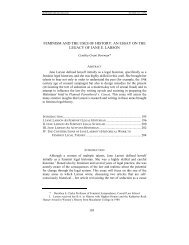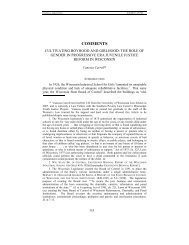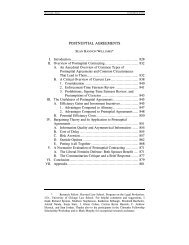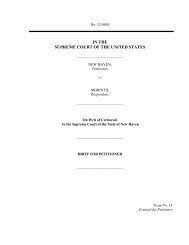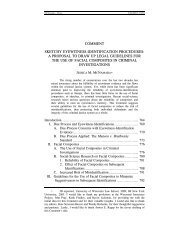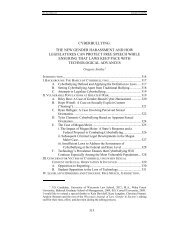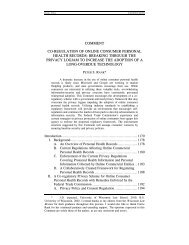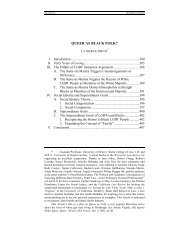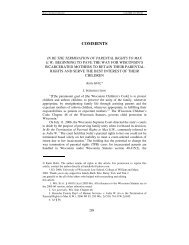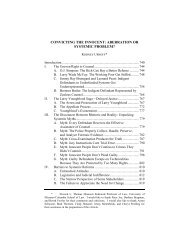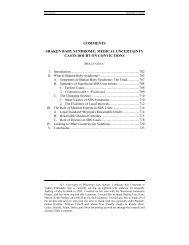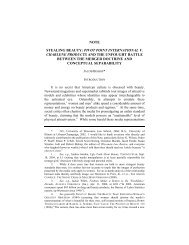note a guide to waiver after echostar and seagate - UW Law School
note a guide to waiver after echostar and seagate - UW Law School
note a guide to waiver after echostar and seagate - UW Law School
Create successful ePaper yourself
Turn your PDF publications into a flip-book with our unique Google optimized e-Paper software.
BELDEN - FINAL 11/29/2007 4:08 PM<br />
2007:933 A Guide <strong>to</strong> Waiver After EchoStar <strong>and</strong> Seagate 937<br />
communicated <strong>to</strong> the client; 35 <strong>and</strong> (3) documents referencing a<br />
communication between the at<strong>to</strong>rney <strong>and</strong> client concerning the case’s<br />
subject matter that were not actually communicated <strong>to</strong> the client. 36 The<br />
court <strong>note</strong>d that the first category fell under the scope of the <strong>waiver</strong> of<br />
at<strong>to</strong>rney-client privilege <strong>and</strong>, thus, was discoverable. 37<br />
The court of appeals found that work product in the second<br />
category (which the at<strong>to</strong>rney never communicates <strong>to</strong> the client) was not<br />
discoverable. 38 Because such work product embodies only the thoughts<br />
of the at<strong>to</strong>rney, it has little bearing on the alleged infringer’s state of<br />
mind. 39 Therefore, the court found the policies supporting the workproduct<br />
doctrine outweighed any value that this type of work product<br />
might provide <strong>to</strong> the willfulness inquiry. 40<br />
In contrast, the court of appeals cautiously found work product <strong>to</strong><br />
be discoverable in the third category (referencing a communication<br />
between the at<strong>to</strong>rney <strong>and</strong> client but not communicated <strong>to</strong> the client). 41<br />
Unlike work product that falls within the second category, the court<br />
found work product that references or describes a communication<br />
between the at<strong>to</strong>rney <strong>and</strong> client <strong>to</strong> have substantial value in determining<br />
what communications the at<strong>to</strong>rney actually made <strong>to</strong> the client. 42 The<br />
court <strong>note</strong>d the danger of such documents possibly containing work<br />
product that falls within the second category, suggesting that the parties<br />
should carefully redact such work product before production. 43<br />
On its face, EchoStar appears <strong>to</strong> be a step-by-step <strong>guide</strong> <strong>to</strong> the<br />
scope of <strong>waiver</strong> of at<strong>to</strong>rney-client privilege <strong>and</strong> work-product immunity<br />
when an alleged infringer relies on the advice-of-counsel defense in an<br />
action for willful patent infringement. To be sure, the opinion<br />
substantially clarifies a previously murky, complicated area of patent<br />
law, particularly with respect <strong>to</strong> the law governing work-product<br />
immunity. Inspection of district court cases subsequent <strong>to</strong> EchoStar<br />
35. EchoStar, 448 F.3d at 1302.<br />
36. Id. (citing Thorn EMI N. Am., Inc. v. Micron Tech., 837 F. Supp. 616,<br />
622–23 (D. Del. 1993)). The Federal Circuit acknowledged that these three categories<br />
were not necessarily exhaustive. Id. at 1302 n.3.<br />
37. Id. at 1302.<br />
38. Id. at 1303.<br />
39. Id. at 1304.<br />
40. Id.<br />
41. Id. As an example of such work product, the court wrote that “if an<br />
at<strong>to</strong>rney writes a memor<strong>and</strong>um or an e-mail <strong>to</strong> his associate referencing a phone call<br />
with the client, in which he indicates that he discussed the client’s potential<br />
infringement, then such a memor<strong>and</strong>um is discoverable.” Id.<br />
42. Id.<br />
43. Id.




